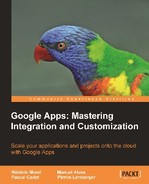The IMAP method that we describe here relies on the protocol with the same name: Internet Message Access Protocol (IMAP). It can be used by nearly any mail solution, because IMAP is a widespread standard (for example, Microsoft Exchange, Cyrus Servers, IMPA mail, Dovecot, and so on).
This method only allows message fetching. Processes run directly on the server side on the Google platform. The mail is transferred directly from the existing mail to Gmail.
In contrast with the POP protocol that downloads messages on the user's desktop and thus removes them from the server, the IMAP protocol allows synchronizing the content of the hierarchy of messages with the mail client (in our case Gmail). When using IMAP, the messages are not deleted from the server.
This method allows an administrator to transfer the content of existing accounts to Google accounts without any intervention from the users. Mechanisms, which we shall describe below, can automate these tasks making this an interesting option when the number of users is large.
Remember that the prerequisites for this method are:
- The IMAP feature should be enabled in Google Apps
- All username and password credentials should be provided to Google
- Allow Google access to the IMAP port (this can require some firewall tuning)
The fetching of messages using IMAP happens as follows:
- Set up of the connection by an administrator on the Google Apps console. The exact network address of the mail server should be provided to Google, as well as the security options (none, SSL, or STARTTLS), and the folders to be excluded from the transfer (for example, newsgroup data, shared folders, folders containing contacts, or calendar events).
- Defining the user accounts that should be migrated. Assuming the Google accounts have already been created, this amounts to matching each of them with its corresponding existing account (credentials). This can either be set manually or by using a batch with CSV files when several accounts are involved.

Defining which account to migrate in Google Apps
- The last step is simply to launch the transfer.
Beware, though, that the massive upload of messages is not misinterpreted as a denial of service attack by the mail server. The risk of blackout can be mitigated by defining pauses in the traffic between Google and the IMAP server.
If none of the above solutions we have presented works, there remains the option to use the Google APIs (see Chapter 9), which allow the development of custom migration solutions. However, in most cases, custom development is used to complement the existing solutions, rather than as a substitute.
Still another option would be to make use of partner solutions that can be found on the Google Marketplace.
